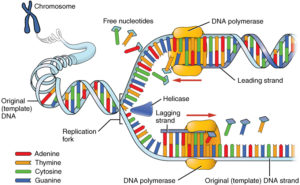34 DNA Replication in Eukaryotes
Because eukaryotic genomes are very complex, DNA replication is a very complicated process that involves several enzymes and other proteins. Recall that eukaryotic DNA is bound to proteins known as histones to form structures called nucleosomes. During initiation, the DNA is made accessible to the proteins and enzymes involved in the replication process. How does the replication machinery know where on the DNA double helix to begin? It turns out that there are specific nucleotide sequences called origins of replication at which replication begins.
Table 1: Important proteins involved in DNA replication
| Protein | Function |
| Helicase | Breaks hydrogen bonds connecting complementary strands of DNA and unwinds and opens DNA double helix |
| DNA Polymerase | Pairs new DNA nucleotides that are complementary to the existing strands to create two new strands of DNA |
| Telomerase | Copies sequences at the ends of linear chromosomes, called telomeres |
| Repair enzymes | Repair mismatched or damaged nucleotides so that errors are not copied |

References
Unless otherwise noted, images on this page are licensed under CC-BY 4.0 by OpenStax.
OpenStax, Concepts of Biology. OpenStax CNX. May 18, 2016 http://cnx.org/contents/s8Hh0oOc@9.10:2ousESf0@5/DNA-Replication


Feedback/Errata